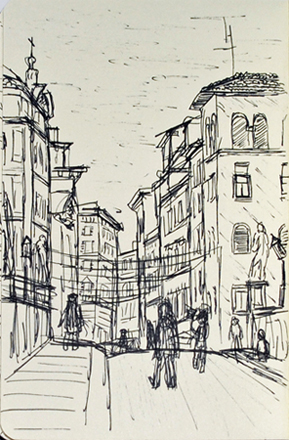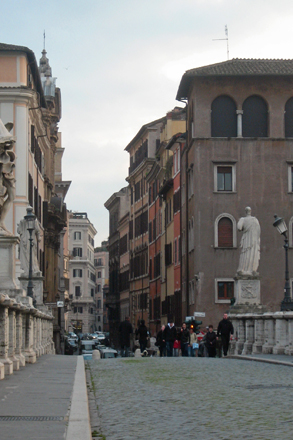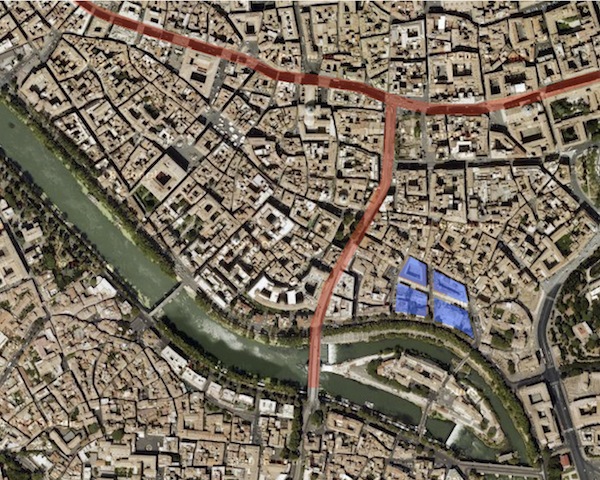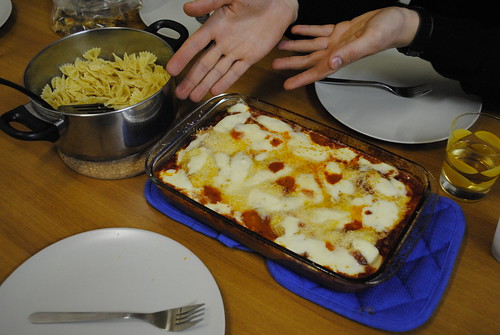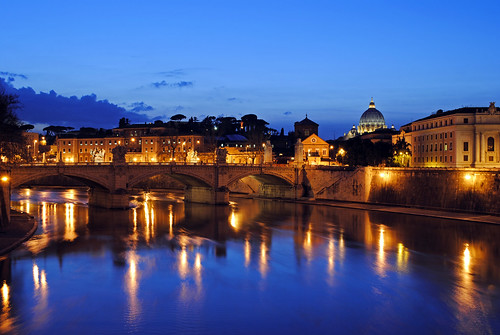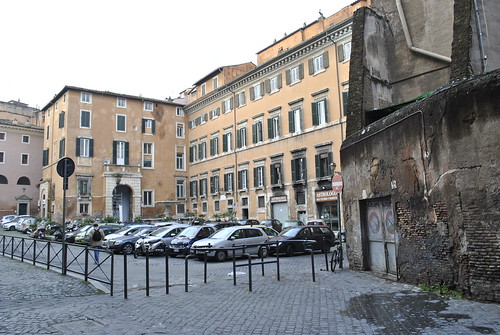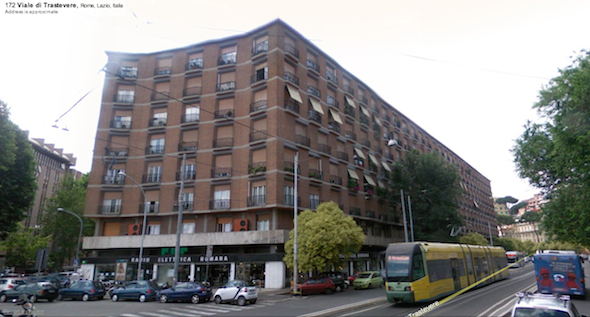Last weekend was full of travel. Last Thursday to Friday (Feb 4-5) we had a short overnight class trip to Perugia, Umbria, followed by a three day weekend for travel on our own. I headed up to Norway with three others and it was a blast, but I’ll talk about that in my next post.
We left Rome around 8am on Thursday aboard a double decker charter bus, which was kind of fun. It was my first time out of the city since arriving about a month ago, so I was looking forward to seeing the countryside and just somewhere else besides Rome.
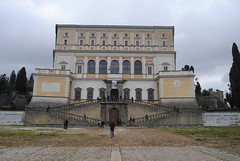 On the way to Perugia we made a few side stops along the way. First in the small hill town of Bagnaia to visit Villa Lanta (16th century) with an elaborate formal garden with fountain and water features flowing down the hill above the town. We stayed there for a little over an hour to explore and do some sketching. Our second stop was at Palazzo Farnese (photo to left), an enormous 16th century mansion in a very rural town Caprarola. Similar to Villa Lanta, it sat above overlooking much of the small town. On the short walk from the bus we had majestic views of the deep valleys and hillside dwellings (photo at top). We only went through one floor of the Palazzo, which were all elaborately decorated with frescos painted on just about every wall and ceiling surface. Then we made a quick stop nearby for food tasting of a few different local foods, wines, and naturally carbonated water.
On the way to Perugia we made a few side stops along the way. First in the small hill town of Bagnaia to visit Villa Lanta (16th century) with an elaborate formal garden with fountain and water features flowing down the hill above the town. We stayed there for a little over an hour to explore and do some sketching. Our second stop was at Palazzo Farnese (photo to left), an enormous 16th century mansion in a very rural town Caprarola. Similar to Villa Lanta, it sat above overlooking much of the small town. On the short walk from the bus we had majestic views of the deep valleys and hillside dwellings (photo at top). We only went through one floor of the Palazzo, which were all elaborately decorated with frescos painted on just about every wall and ceiling surface. Then we made a quick stop nearby for food tasting of a few different local foods, wines, and naturally carbonated water.
The next leg of the bus trip was longer, going through very hilly and forested areas. The road had very sharp turns, switching back and forth up and down terrain. The countryside was beautiful and a nice change of scenery from the dense grittiness of Rome. Despite winter, much of the ground was still mostly green.
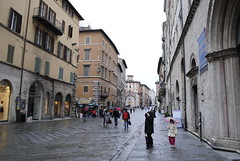 We arrived in Perugia around 5:30pm, just as it was getting dark. Outside of town there were occasional small industrial buildings along the highway. Entering the city was actually quite sudden. I was surprised by the size and modernity of the newer areas, with more towers, glass and steel than can be found in Rome. But this certainly did not characterize all of Perugia, which originated as a medieval fortress atop a hill. The old historic center remains a vibrant place, connected to the newer city below by MiniMetro, an automated people mover system, as well as an extensive escalator corridor going up the hill.
We arrived in Perugia around 5:30pm, just as it was getting dark. Outside of town there were occasional small industrial buildings along the highway. Entering the city was actually quite sudden. I was surprised by the size and modernity of the newer areas, with more towers, glass and steel than can be found in Rome. But this certainly did not characterize all of Perugia, which originated as a medieval fortress atop a hill. The old historic center remains a vibrant place, connected to the newer city below by MiniMetro, an automated people mover system, as well as an extensive escalator corridor going up the hill.
A wide pedestrian street Corso Vannucci at the top is flanked by several tiny “streets” that crawl up and down the terrain, winding around agglomerations of buildings. Unlike most of the medieval streets in Rome, the majority of these were completely inaccessible except on foot, many only a meter or so wide. A lot were also built over, either partially or completely, making the typical meaning of street even more inapplicable. They were very foreign, especially since they are all still functioning, providing access to operating businesses and residences. The multidimensional, multilayered urbanism here simply cannot be found in America.
 Hilltop Perugia was very posh with several stylish outlets along Corso Vannucci. It was very clean compared to Rome and the small side streets were very well lit. The paving material was also a lighter stone and brick compared to the standard dark gray cobblestone used most everywhere in Rome.
Hilltop Perugia was very posh with several stylish outlets along Corso Vannucci. It was very clean compared to Rome and the small side streets were very well lit. The paving material was also a lighter stone and brick compared to the standard dark gray cobblestone used most everywhere in Rome.
Our hotel (Hotel Priori) was just off Corso Vannucci on one of these side streets. That evening we had a group dinner with all students and professors at All Mangiar bene (translates: “All Eating Well”) located down one of the side vias. It was a multi course Italian dinner with two appetizers, soup, spaghetti, salad, turkey dish, pork chops and sausage; followed by dessert, coffee, and a lemon liquor. Needless to say, it was intense and very filling. A brick arched ceiling characterized the dinning room, with only a few small windows at one end, giving it a very medieval, almost dungeon-like vibe.
The following day on Friday was left for exploration and sketching. I walked down the hill first to find the train station with a few friends who needed to catch a bus there later to get to their own weekend travels. I then wandered around the modern city around and took the MiniMetro back up to the top. It was drizzly, gloomy and cold that day so everyone was pretty much ready to leave when we the bus came back around 3pm. The bus trip back to Rome was pretty uneventful with one quick stop at an AutoGrill truck stop. Back in Rome it was pouring rain, not making for a fun way back to the apartment. We were dropped back off at the Piramide Metro station where we had met the bus on Thursday, despite driving right by the apartment where the majority of us live. Waiting ten minutes in the pouring rain for a local bus to come was no fun at all, but hey, its Rome.
Perugia was a nice short trip outside of Rome and neat to see a smaller Italian city. See photos here.
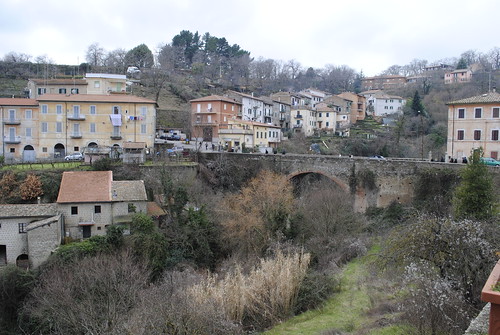
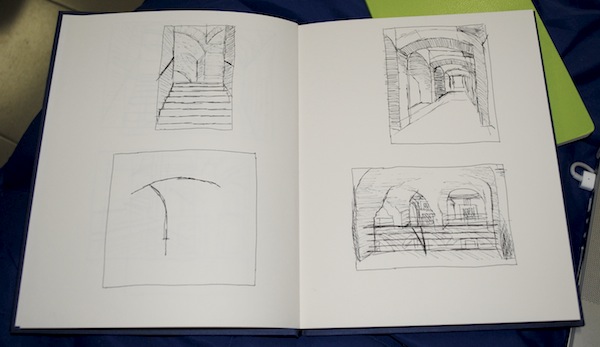
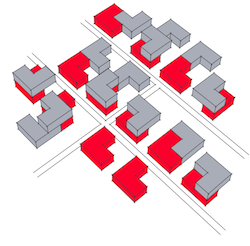 Some of the architects who spoke the day before came for a while and walked around to check on the progress. Nina Maritz talked to us earlier on when we were still clarifying specifics of materials and orientation. Later one Giorgio Goffi stopped by, but only spoke in Italian. He had suggested considering our L-shape as a starting point and how they could be used to create a variety of different sizes and forms. This was not a bad idea, but it made it more difficult to clarify specific decisions regarding solar orientation, tectonics, and of course organization. We attempted to show both ideas – the variation that Goffi suggested, and the more specific possibility of one L. However the new abstract L variety got rid of the original relationship between adjacent units, making several material and orientation decisions less significant. In the end we sort of ran out of time and had a less than stellar presentation – we both agreed it was not good graphically and did not represent our ideas well. But we discussed a lot of interesting strategies during the day, so it was a really good learning experience.
Some of the architects who spoke the day before came for a while and walked around to check on the progress. Nina Maritz talked to us earlier on when we were still clarifying specifics of materials and orientation. Later one Giorgio Goffi stopped by, but only spoke in Italian. He had suggested considering our L-shape as a starting point and how they could be used to create a variety of different sizes and forms. This was not a bad idea, but it made it more difficult to clarify specific decisions regarding solar orientation, tectonics, and of course organization. We attempted to show both ideas – the variation that Goffi suggested, and the more specific possibility of one L. However the new abstract L variety got rid of the original relationship between adjacent units, making several material and orientation decisions less significant. In the end we sort of ran out of time and had a less than stellar presentation – we both agreed it was not good graphically and did not represent our ideas well. But we discussed a lot of interesting strategies during the day, so it was a really good learning experience.